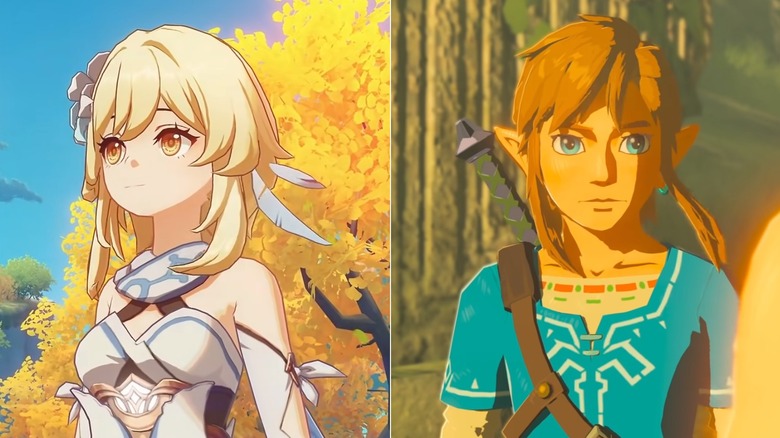How Genshin Impact's Release Really Compares To Zelda: Breath Of The Wild
Reality has a tendency to demolish preconceived notions. When miHoYo announced its free-to-play title Genshin Impact, many gamers were livid. Audiences derided the game because of more than a few similarities to The Legend of Zelda: Breath of the Wild. One particularly upset fan publicly destroyed his own PS4 due to these similarities. However, now that Genshin Impact has released, some individuals have conceded that they might have been too hasty to issue judgement.
Still, when one game draws inspiration from another, comparisons are inevitable — especially when it comes to launch numbers. In the world of video games, two of the most important figures are revenue and downloads (or sales for physical games). If Niko Partners senior analyst Daniel Ahmad is correct, Genshin Impact has these numbers in spades.
Even before Genshin Impact launched, the game attracted a cavalcade of fans. 20 million gamers reportedly pre-registered to download the title, and a slightly lower but still respectable 17 million actually installed it over the following few days. Genshin Impact released on mobile devices, PlayStation 4, and PC (and a Nintendo Switch version is waiting in the wings).
Genshin Impact's revenue is likewise surprisingly high, thanks in no small part to microtransactions. Since the game is free-to-play, all of its revenue comes through purchasing convenience items — such as powerful weapons and EXP scrolls — and RNG loot boxes called Wishes. You obtain one random weapon or playable character per Wish, and if you purchase a bundle of 10 Wishes, you are guaranteed at least one rare reward. The more Wishes you buy, the more rare items you receive. Judging by Genshin Impact's profits, people have been purchasing a ton of microtransactions.
Within one week of Genshin Impact's release, it accrued an estimated $50 million in revenue, accounting for all platforms. Five days later, that amount supposedly doubled to over $100 million, securing the game's title as "the most successful launch for an original IP from a Chinese dev." Moreover, PC Gamer reported that the title had recouped its development costs. The secret of Genshin Impact's success? According to miHoYo co-founder Cai Haoyu, filling the game with cute anime girls and leaning on male gamers' desire to connect with them has played a major role in the company's strategy — a strategy he called "paying for love."
Compared to Genshin Impact, Breath of the Wild's success was downright glacial.
Unlike Genshin Impact, Breath of the Wild didn't have the luxury of releasing on multiple, unrelated platforms. The game launched on two consoles: the Nintendo Wii U and Nintendo Switch. Breath of the Wild only moved 1.67 million units on the Wii U, while the Switch version garnered 18.6 million purchases, pushing the total sales just over 20 million. Normally, that would imply BotW outsold Genshin Impact, but BotW's sales numbers come with a monumental caveat: they're the game's lifetime sales. In truth, it only sold 230,981 copies its first week in Japan and didn't break 1 million sales for a full month. Genshin Impact did in two weeks what BotW eked out in three years.
Much like its sales, Breath of the Wild's revenue tallied up slowly. While Nintendo doesn't usually post individual game sales, the company doesn't usually offer discounts, either, so it's simple enough to conservatively estimate revenue. Since BotW has sold for $60 since it launched, with a quick bit of math, it's easy to estimate the game raised over $13 million its first week, accrued over $78 million after one month, and achieved a lifetime revenue of over $1.2 billion. However, there is a difference between revenue and profit.
Genshin Impact reportedly recouped the cost of development at the $100 million revenue mark. Anything else the game earns should be profit, right? Not exactly. MiHoYo will provide a constant stream of new content, which means it will require a similarly constant stream of microtransaction purchases to break even — or turn a profit. Breath of the Wild, meanwhile, supposedly required only 2 million sales to earn back initial development costs, not including the cost of DLC development. Every BotW copy sold after 2 million was theoretically profitable for Nintendo (again not counting DLC).
In the end, Genshin Impact has pushed more copies, raised more revenue, and earned back its development costs in a shorter amount of time than Breath of the Wild. However, whether Genshin Impact earns enough revenue to offset continued development costs is a different kettle of fish. Only time will tell if Genshin Impact's speedy short term earnings can beat Breath of the Wild's reliable long term profits.

